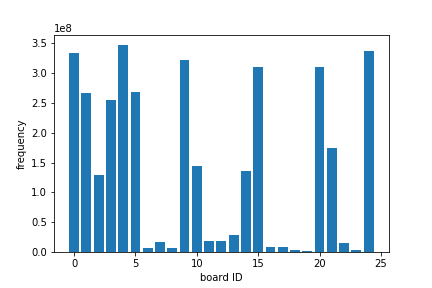GoStone --> GoBlock -> GoBoard
The game board, GoBoard are consists of GoBlocks, and GoBlock is consist of GoStones.
I do static allocation of GoBlocks and GoStone per GoBoard.
GoState is the interface to react between the saved states.
The Z-Hash is used to check if the board position is repeated. In our small board analysis, Positional SuperKo is allowed, meaning that we only have to check whether there is a Ko in our move to determine whether the move is legal.
The Z-Hash is initially generated using GoFunction::CreateZobristHash, with fixed uint32_t seed = 0xdeadbeef;. We prepare Z-Hash for the every possible stone of appearance on the board, which includes "Empty"(0), "Black"(1), "White"(2).
Find all "legal & reduced" serial numbers for the given board size.
This phase I created a constructor that takes serial numbers in. It calles GoBoard::SetStone to place the stones onto the board without maintaining gaming details of the board. (so it is a modification version of GoBoard::Move). If anything eat or self-eat move happens when SetStone, the construction will end and the for-loop in FindAllPossibleSerial/main.cpp will go on to try the next serial number.
Actually not that many function is related in this phase, because I only want to initialize the board. However the correctness of this phase also have asserted that GoBlock and GoStone maintenance is bug-free.
- For all possible
serial...GoBoard(serial)- Calls
SetStonefor each stone on theserial, which theGoStoneis on positionid- Create a new
GoBlock - Get neighboring
GoBlocksofidusingGetNeighborBlocksGetNeighborBlockscallsGetBlockIdByCoordfor each neighboring positionGetBlockIdByCoordcallsFindCoord, which stones are herded together using disjoint-set
- If neighboring block is of the same color, call
GoBlock::TryMergeBlock - If neighboring block is opponent and with only 1 liberty left, the construction fails (ERROR CODE -2)
- If the merged block of my own have no liberty, then the construction fails (ERROR CODE -1)
- After
GoBlock::MergeBlock, useGoBoard::RecycleBlockto recycle the blocks.
- Create a new
- Calls
- If construction does not fail, we try
RotateClockwiseand do onceFlipLRfor every rotation.- If
GetSerialreturns numbers that is smaller than the currentserial, then is should be reduce-able.
- If
- If it is not reduce-able, then we acccumulate an
1bit onto the file - Else we accumulate a
0bit onto the file.
By the master thesis, there are about 414.2G of states in a 5x5 board. I would save the 1 bit per state
- If legel, an
1bit will be appended - else , a
0bit will be appended.
48.1G byte needed to save all the legal states.
Taking the data generated from the previous phase, this part I would still generate data in a sparse manner. Meaning
that for a illegal serial (represented as a 0 bit in 1st phase data), I would still output 4 bytes full zero for the
serial number.
For a serial number, 4 bytes are used to record its possible Ko position. (LSB style) Meaning that if you fetch
uint32_t x representing for this serial number, then ((x>>(id))&1) == 1 means that on position id there can be a
Ko.
Also note that boards now all represent as a state where it is the black's turn. So for the checking I will view on available white blocks on the board.
Ko mainly distribute on corners or border lines.
- For all legal
serial(decoded from data saved in previous phase)- For all position of
serial(saved in 32 bit)- If there is a ko position for this stone's neighbor
- Set neighbor to a possible ko position
- Write the 32 bit into buffer
- For all position of
- When buffer is full, write to file
For each position, generate 32 bit record the ko positions. The 0th bit (least bit) represents for position id = 0. Checkout the data splitting in result/5x5.log for argument setting of next phase.
